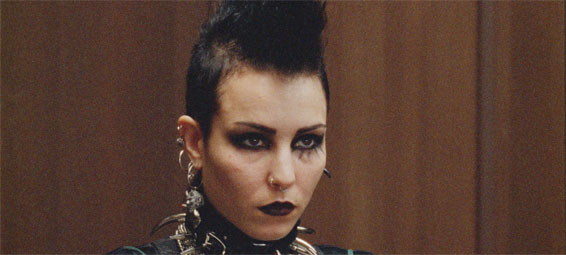The charm and visual satisfaction of the trio of films based on Swedish writer Stieg Larsson’s books about the girl with the dragon tattoo climaxes in a courtroom scene in the last film in the series, The Girl Who Kicked the Hornets’ Nest. “The girl,” Lisbeth Salander (Noomi Rapace) enters the stuffy, wood-paned room in a shining black leather outfit fitted with studs and spikes, and chains. She wears two earrings in her nose, a Mohawk on her head, and black eye shadow bursting out from her eyes like a star burst. She sits next to her lawyer and stares intently across the room at the prosecution. If this badass girl isn’t going to win her case, there is no justice in the cinema.
If you haven’t seen the first two films in the trilogy, The Girl With The Dragon Tattoo and The Girl Who Played With Fire, then you better get up to speed, because the third film makes all three wonderfully enjoyable, whereas at first viewing they seemed filled with holes and mismanaged characters. Hornet’s Nest picks up right after the end of Played With Fire.
Salander has a bullet removed from her head that was put there during a fight at the end of the previous film with her abusive Russian spy father and her freakish, Frankenstein half-German half-brother. Salander is locked-down at the hospital during her recovery because she will be placed on trial for attempted murder of her father (she managed to put an axe in his head at the close of the last film). Salander was obviously acting in self-defense, but a conspiratorial group within the Swedish government seeks to use the trial to silence Salander, who has uncovered too much about their nasty dealings and decades-old corruptive schemes.
It is a bit too much story to swallow if you haven’t seen the other films, but if you start from the beginning, this complicated plot emerges slowly and carefully. In the first film we are only introduced to Salander through her dealings with the celebrity journalist Mikael Blomkvist (Michael Nyqvist), who is investigating a decades-old murder at a family estate in the north of the country. In that film, Salander’s presence is a little awkward because she is such a visual force and yet only a slight character. Brought to full-fruition in the subsequent films, Salander emerges as an incredibly memorable and thrilling character. She is a female hero like none before, possessing a particular sense of courage, wit, strength, guile, and pure heroic will that, remarkably for the movies, doesn’t come off as the product of a testosterone transfusion. The sub-cultural force that is Lisbeth Salander is part action hero, part societal mutation, a callous growth that exists in opposite relation to the hypocrisy and cruelty of power structures. In this way, she is one of the few true punk heroes that actually rings true: not a manifestation of a marketable, countercultural style, but a 21st century Batman in a film that has the heart, intelligence, and pure thriller instincts to make her deeper and darker than the best cinematic superheroes.
In Hornet’s Nest, the task at hand is acquittal, and that duty lies in the hands of Blomkvist, who works to obtain evidence to win Salander’s case. That evidence will also bring down the conspiratorial government agents who fight back hard to silence Blomkvist and his investigative magazine, Millennium. Director Daniel Alfredson keeps things spunky and moving, allowing the details of the complicated intrigue to bite and not submerge the viewer. When Salander and Blomkvist bring the corrupt ring down, it is a moment as satisfying and sentimental as any Hollywood happy ending. But Salander’s mere presence keeps things balanced, her awkward way lending the film’s world depth of spirit amidst the comic fun.





